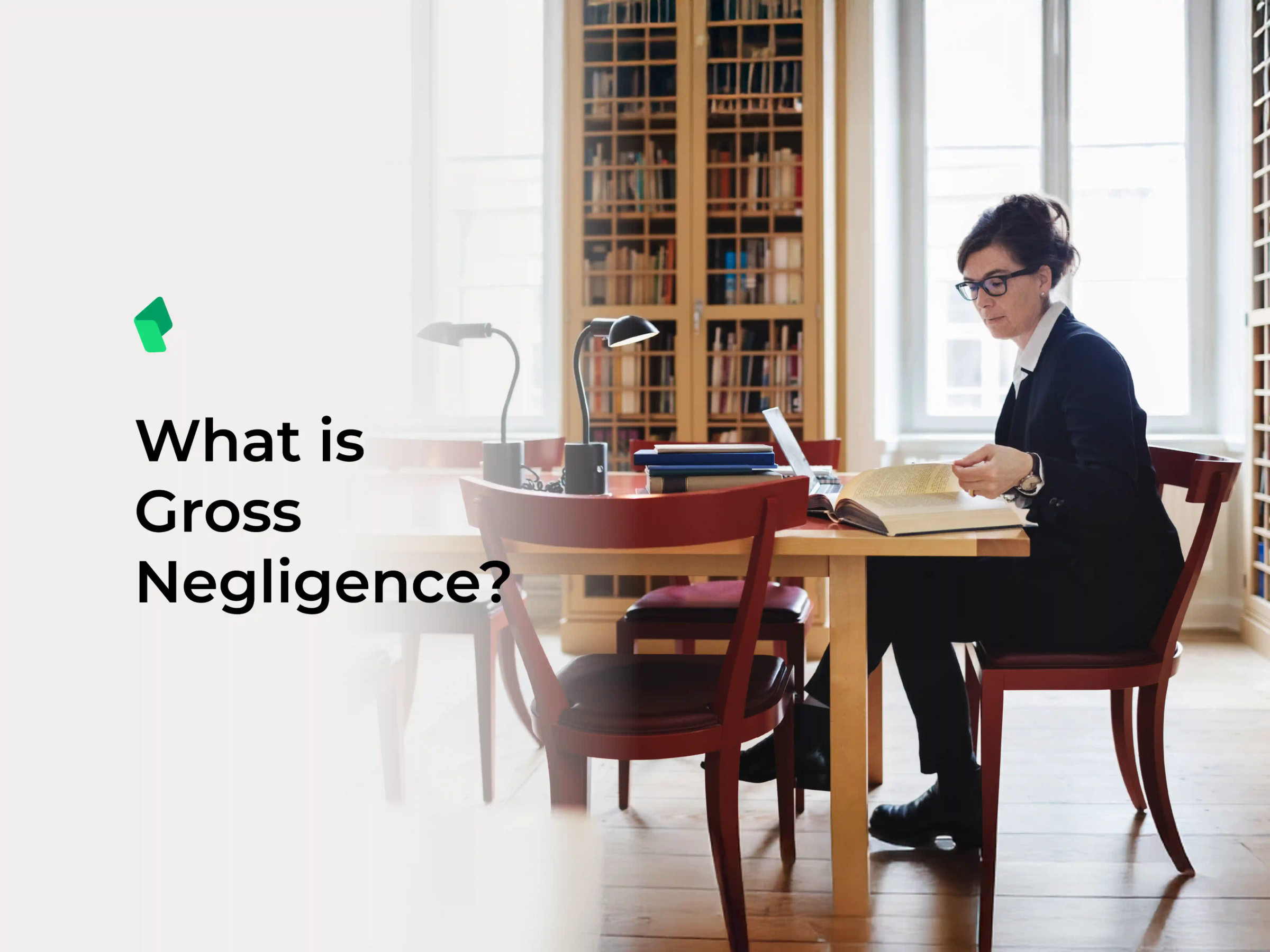The delineation between gross negligence and negligence significantly impacts legal strategies, client counseling, and the potential outcomes of cases. With this in mind, brushing up on this information never hurts.
We’ll provide definitions, examples, and recent developments concerning gross negligence in this blog post, offering legal practitioners a comprehensive understanding necessary for effective case management.
What is Ordinary Negligence?
Ordinary negligence is characterized by the failure to exercise the level of care that a reasonably prudent individual would under similar circumstances, resulting in harm or damage.
This form of negligence is foundational in many personal injury claims, where the defendant’s actions, though unintentional, fail to meet the standard of reasonable care.
Examples of Ordinary Negligence:
Minor Car Accidents: A driver neglects to observe a stop sign, causing a minor collision.
Slip and Fall Incidents: A business owner fails to address a spill in their store, leading to a customer slipping and sustaining injuries.
What is Gross Negligence?
Gross negligence involves a severe lack of care, demonstrating a blatant disregard for the safety and well-being of others. Unlike ordinary negligence, gross negligence reflects actions or omissions that are reckless and significantly deviate from what a reasonable person would consider acceptable.
Examples of Gross Negligence:
Driving at Excessive Speeds in Crowded Areas: Operating a vehicle at high speeds through areas dense with pedestrians, displaying a reckless indifference to potential harm.
Ignoring Safety Protocols During Dangerous Activities: A supervisor deliberately neglects established safety procedures on a construction site, resulting in significant injuries to workers.
Key Differences Between Negligence and Gross Negligence
Ordinary negligence refers to a failure to exercise the care that a reasonably prudent person would in similar circumstances, resulting in unintended harm;it involves actions that are careless but not intentional. For example, a driver texting while driving and causing a minor collision exemplifies ordinary negligence. This type of negligence is essentially a lapse in attention or failure to foresee the consequences of one’s actions.
On the other hand, gross negligence involves a much higher degree of carelessness, bordering on willful misconduct;it represents a blatant disregard for the safety and well-being of others. This form of negligence is so severe that it demonstrates a conscious indifference to the potential consequences. For instance, a doctor performing surgery while impaired or a driver speeding through a crowded pedestrian area illustrates gross negligence.
Compensatory and Punitive Damages
The legal implications of gross negligence are significantly more severe than those of ordinary negligence. While both types of negligence can result in compensatory damages (covering medical expenses, lost wages, and pain and suffering), gross negligence can also lead to punitive damages. Punitive damages are intended to punish the defendant and deter similar egregious behavior in the future. Courts are more likely to award punitive damages in cases of gross negligence due to the reckless nature of the actions involved.
Handling by Courts
Courts treat cases of ordinary negligence and gross negligence differently. For example, ordinary negligence cases often focus on whether the defendant failed to exercise reasonable care. However, gross negligence cases require proving that the defendant’s actions were beyond mere carelessness and include reckless or willful misconduct. This higher threshold means that plaintiffs in gross negligence cases must demonstrate that the defendant acted with a conscious disregard for the safety of others.
Practical Implications in Legal Practice
Understanding the distinction between ordinary and gross negligence is essential, as it impacts how cases are approached, argued, and the types of damages pursued. For instance, liability waivers signed by plaintiffs might be invalidated in cases of gross negligence, allowing for claims despite initial agreements to the contrary.
Additionally, the defense of the assumption of risk is less robust against claims of gross negligence, making it easier for plaintiffs to succeed in such cases.
Proving Negligence and Gross Negligence in a Case
To establish negligence or gross negligence in a legal case, specific elements must be proven. While both types require showing a duty of care, breach, causation, and damages, proving gross negligence involves demonstrating a significantly higher degree of recklessness or intentional misconduct.
Duty of Care
The duty of care refers to the legal obligation to act in a manner that avoids causing harm to others. It is a foundational element in both ordinary and gross negligence cases.
Ordinary Negligence: Involves a failure to exercise the level of care that a reasonably prudent person would under similar circumstances. For instance, a driver has a duty to follow traffic laws to prevent accidents.
Gross Negligence: Requires a more egregious breach, characterized by a blatant disregard for the safety and well-being of others. This might include actions that a reasonable person would consider obviously dangerous or irresponsible, such as ignoring safety warnings and protocols.
Breach of Duty
Ordinary Negligence: A breach occurs when the defendant fails to meet the expected standard of care, such as a store owner neglecting to clean up a spill, leading to a slip and fall incident.
Gross Negligence: The breach must show a significant deviation from reasonable behavior, often bordering on willful misconduct. For example, operating machinery without following mandatory safety procedures despite knowing the risks involved.
Causation
Causation involves proving that the defendant’s breach of duty directly caused the plaintiff’s injuries. This requires establishing:
Actual Cause: The injury would not have occurred but for the defendant’s actions.
Proximate Cause: The injury must be a foreseeable result of the defendant’s actions.
Damages
The plaintiff must demonstrate that they suffered actual harm or losses due to the defendant’s breach. This can include:
Economic Damages: Such as medical expenses, lost wages, and property damage.
Non-Economic Damages: Including pain and suffering, emotional distress, and loss of enjoyment of life.
Evidence Requirements
In personal injury cases, the type and quality of evidence presented can significantly influence the outcome. Proving negligence, whether ordinary or gross, requires a structured approach to gathering and presenting evidence. The burden of proof is higher for gross negligence, demanding more substantial and compelling evidence.
Ordinary Negligence
Documentation: Medical records, accident reports, and maintenance logs that show a failure to meet the standard of care.
Witness Testimony: Eyewitness accounts providing details of the incident.
Expert Testimony: Insights from professionals on how the defendant’s actions deviated from standard practices.
Gross Negligence
Clear and Convincing Evidence: Proof that demonstrates reckless disregard for the safety of others.
Recklessness: Evidence illustrating a severe deviation from normal behavior, such as prior warnings ignored by the defendant.
Prior Warnings: Documentation or testimony showing that the defendant was aware of risks and chose to ignore them.
Gross Negligence Lawsuit Examples
Below you will find some landmark personal injury lawsuit examples that illustrate gross negligence.
Ford Pinto Case (1970s)
Ford faced allegations of gross negligence in designing the Ford Pinto, which had a fuel tank susceptible to explosions in rear-end collisions. The case highlighted corporate decisions prioritizing cost savings over safety, leading to significant legal and public scrutiny.
Scott v. McDonald's Corp (2017)
This widely-known case involves Stella Liebeck, who suffered third-degree burns from hot coffee purchased at a McDonald's drive-thru. The jury awarded substantial damages, including punitive damages, based on evidence suggesting McDonald's was grossly negligent in maintaining excessively high coffee temperatures and failing to warn customers about the potential risks.
Volkswagen Emissions Scandal (2015)
The Volkswagen emissions scandal, also known as "Dieselgate," began in 2015 when the US Environmental Protection Agency (EPA) found that VW had installed software in its diesel vehicles to cheat emissions tests. This scandal revealed that the vehicles emitted pollutants up to 40 times above the legal limit during normal driving conditions. VW faced substantial fines and a significant hit to its reputation and financial stability.
Type of Negligence Implications for Personal Injury Cases
The type of negligence involved in a personal injury case significantly impacts the legal strategy and potential outcomes. Understanding these nuances is crucial for attorneys to effectively represent their clients and maximize their recovery.
Comparative Negligence
In comparative negligence, the fault is apportioned among all parties based on their level of responsibility for the incident. This means that if a plaintiff is partially at fault, their compensation is reduced proportionally. For example, if a plaintiff is found to be 30% at fault for an accident and the total damages are $100,000, their compensation would be reduced to $70,000. This approach allows plaintiffs to recover damages even if they are partially responsible, but the recovery amount is diminished according to their degree of fault.
Contributory Negligence
In jurisdictions that follow contributory negligence, the plaintiff is barred from recovering any damages if they are found to be even slightly at fault for the incident. This strict standard can significantly impact a plaintiff’s ability to recover compensation, making it essential for attorneys to establish that their client was not at fault at all.
Gross Negligence
Gross negligence involves a severe lack of care or willful disregard for the safety of others. This type of negligence can lead to punitive damages in addition to compensatory damages. Punitive damages are intended to punish the defendant and deter similar behavior in the future. Understanding the higher burden of proof required for gross negligence is critical for attorneys aiming to secure substantial awards for their clients.
How Personal Injury Lawyers Can Succeed in Negligence Cases
Here are five tips for personal injury lawyers to navigate these complexities and maximize client outcomes:
1. Thoroughly Understand the Facts
Start by thoroughly investigating the incident and gathering all relevant facts. This includes interviewing witnesses, reviewing medical records, and collecting any other evidence that supports your client's claim. A comprehensive understanding of the incident will help build a strong case.
2. Establish Duty and Breach
Clearly establish that the defendant owed a duty of care to the plaintiff and that this duty was breached. Provide evidence showing how the defendant's actions or negligence led to the injury. This involves demonstrating a clear link between the breach of duty and the harm suffered by the plaintiff.
3. Document Damages
Keep detailed records of all damages suffered by your client, including medical bills, lost wages, property damage, and any other relevant expenses. This documentation is crucial when negotiating settlements or presenting evidence in court. Accurate and comprehensive records strengthen the case and ensure that all losses are accounted for.
4. Consult with Experts
When necessary, consult with experts such as accident reconstruction specialists, medical professionals, or economists. Their expertise can provide critical insights and strengthen the credibility of your case. Expert testimony can be particularly important in complex cases involving technical details or specialized knowledge.
5. Use Case Management Software
Using personal injury software can streamline the organization of evidence, facilitate detailed documentation, and enhance collaboration among legal teams. Efficient case management is pivotal in building comprehensive arguments and successfully navigating negligence cases, particularly those involving gross neglect.
The Benefits of CasePEER for Personal Injury Attorneys
Personal injury attorneys looking to streamline their case management processes and enhance their practice should consider using CASEpeer. This software is specifically designed for personal injury law firms, helping you manage cases more efficiently, keep detailed records, and collaborate effectively with your team to maximize client outcomes.
Learn more about how CASEpeer can support your practice and improve your case management today. All you need to do is schedule a demo.
About the author

Justin Fisher Content Writer
Justin Fisher is a content writer and SEO strategist for leading legal software companies, including MyCase, Docketwise, and CASEpeer. He specializes in writing about emerging legal technology, financial wellness for law firms, and more.
